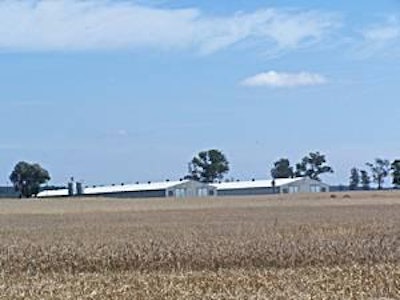
Poland and Romania occupy a fantastic place on the poultry map. Both are large countries with excellent resources and with fantastic potential for growth. There are a number of reasons why these areas are so full of potential for poultry producers.
Location
Romania joined the European Union in 2007, and has the seventh largest population in the Eurozone at 21.5 million. However, poultry consumption is just 18kg per head (compared to a UK average of 27kg per head) so there is a real opportunity for the poultry industry to increasingly provide low-cost, high-protein meat to the Romanian market and beyond.
Poland is a great place to build an export market into Western Europe and it also has great links into the huge Eastern markets, too, being within 24 hours’ travel of a large number of countries.
Over the last 10 years, the number of Parent Stock placed in Poland has risen from 5.5 million to 7.1 million and we can see this peaking at 7.5 million in the next few years.
This has, in turn, created a burgeoning export market with around 2 million birds currently being exported as meat, eggs and chicks to the UK, Switzerland, Germany, Romania and France. A lot of business is also conducted with the Ukraine.
Infrastructure and integration
Historically, the poultry industry in Romania was under government control. Now, private enterprises are responsible for poultry production in the country and the future is looking bright despite the current economic challenges.
Today, Romanian producers are at the cutting edge of industry innovation. The country has embraced the integrated market model. Many producers have control of the entire process from breeding to transport and even retail outlets selling their meat. As in other European countries, the integrated model is paying dividends for Romanian producers.
Romania is one of Aviagen’s key markets in the Central and Eastern European Region: In 2010, Aviagen shipped over 1 million Ross 308 parent stock birds to Romania for the first time and there is certainly scope for more success. In that year alone, domestic production expanded by at least 30% and not only is there a strong internal market but Romania borders five other countries so there is also the potential for export business. Excellent transport links also mean that Romanian producers can look further afield.
Infrastructure is also playing a huge part in Poland’s success. Superb poultry farming resources, from slaughterhouses, feed mills and processing plants to hatcheries, veterinary laboratories and many well-equipped poultry farms mean Poland easily delivered 740 million broilers in 2010.
This is more interesting when you consider how the Polish poultry market is broken up. Around 40% of the businesses are large integrations with private hatcheries taking another 40%. They tend to have their own production facilities and very long contracts with PR and broiler farmers.
The last 20% are small, independent hatcheries, which have short-term contracts with individual farmers (around one to three poultry houses per farm). These small farms are often family-owned and focus on servicing the domestic market, realising that they cannot compete for exports with the larger integrators. However, they are characteristic of the Polish industry and work very well together. This unique mix of companies is likely to remain a feature of the Polish industry for a long time to come.
Tackling biosecurity
In Romania, biosecurity and prevention of disease is, understandably, still an important subject in a country that has suffered a lot through avian influenza and Newcastle disease in the past. However, modernisation, education and understanding are lowering the risks.
Poland, having such a high volume of producers in one market offers an advantage in another area – experienced staff. Sourcing highly skilled people is a real problem across the industry and Aviagen runs a number of schools and sponsorships to encourage talent into the industry, but in Poland there is a great pool of experienced people to draw on.
In turn, using highly skilled staff means that biosecurity in Poland is above average. A decade ago, Poland had a serious salmonella issue, which prompted the whole industry to work together in order to overcome the problem. Since then, Polish farmers have been extremely vigilant in maintaining biosecurity and ensuring that pathogens are kept out of the food chain. It is a collaborative effort.
Investment in infrastructure continues unabated, too. For example, in the last year Cedrob Integration, a leader in the Polish poultry market signed agreements on new PS and broiler operations, including a new feed factory capable of delivering 60,000 metric tons of feed each month, a hatchery with an annual 100 million set capacity and a slaughterhouse to cope with 200,000 broilers per day.
Promising future
Professor Ilie Van, president of the Romanian poultry breeders association and the dean of the animal science college of Bucharest, says; “Romanian industrial poultry farming’s recovery began 16 years ago, when the main bird breeders in Romania formed the Union of Poultry Breeders in Romania. Over these 16 years, industrial poultry production increased from 90,000 mt to 360,000 mt, some 400%. Over the same period, production capacity was upgraded and new technology segments have provided a product alignment with EU rules on food safety and the bird welfare.”
Figures provided by Professor Ilie Van show that in the first months of 2011, Romania’s trade balance on poultry achieved a coverage value of imports for more than 70% of exports, compared with 25% in 2009 and only 8.5% in 2008.
The willingness of the Polish industry to invest not only in current production but also to look forward with optimism shows Poland has recognised the need to gain a competitive advantage through the latest equipment and good genetics. Poland really does have a lot of potential and a unique make up. The traditional, small, family farms will continue to thrive in the domestic market as Poland’s integrators turn to the export world.

















